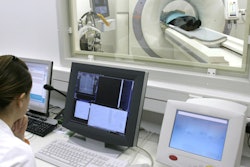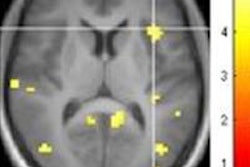Using functional MRI (fMRI), Yale University researchers may have uncovered one of the keys to the obesity epidemic: that ingestion of fructose changes brain activity in regions that regulate appetite and produce feelings of being full. Study results were published in the January 2 issue of the Journal of the American Medical Association.
Test subjects demonstrated different patterns of brain activity on fMRI scans based on whether they consumed drinks laden with fructose or another sweetener, glucose. Those consuming the glucose drinks had lower cerebral blood flow (CBF) in certain regions (indicating that their appetites were satiated), but those drinking fructose did not experience such reductions -- which could result in additional food-seeking behavior.
As lead study author Dr. Kathleen Page and colleagues noted, increases in fructose consumption parallel the prevalence of obesity and high-fructose diets that are thought to promote weight gain and insulin resistance (JAMA, January 2, 2013, Vol. 309:1, pp. 63-70).
In addition, fructose ingestion "produces smaller increases in circulating satiety hormones compared with glucose ingestion, and central administration of fructose provokes feeding in rodents, whereas centrally administered glucose promotes satiety," they wrote. "Thus, fructose possibly increases food-seeking behavior and increases food intake."
The researchers analyzed 20 healthy adult volunteers who underwent two MRI scans with a 3-tesla scanner (Magnetom Trio, Siemens Healthcare) after ingesting fructose or glucose drinks. The researchers used a pulsed arterial spin-labeling fMRI technique to determine regional CBF and blood oxygen level-dependent (BOLD) fMRI sequences to determine functional connectivity.
Page and colleagues then measured relative changes in hypothalamic CBF after glucose or fructose ingestion. While there was no difference in hypothalamic regional cerebral blood flow between the glucose and fructose conditions at baseline, 15 minutes after drink ingestion, the hypothalamic response to glucose and fructose "markedly differed."
Within 15 minutes, glucose significantly reduced hypothalamic CBF (mean, -6.84 mL/g per minute), while fructose did not (5.10 mL/g per minute). Drink intake had a significant effect across all time points, with a greater reduction in hypothalamic CBF after glucose (-5.45 mL/g per minute), compared with fructose (2.84 mL/g per minute).
Page and colleagues found similar results regarding hunger, fullness, and satiety.
While there was no significant difference between glucose and fructose ingestion at baseline, glucose ingestion resulted in a significant difference in predrink and postdrink changes in fullness (mean difference, 1.6) and satiety (mean difference, 1.2), and fructose had no significant effect on fullness (mean difference, 0.7) and satiety (mean difference, 0.3).
The study's results showing a reduction in hypothalamic CBF due to glucose ingestion are consistent with prior fMRI studies in healthy volunteers, the authors noted.
"Glucose but not fructose ingestion reduced the activation of the hypothalamus, insula, and striatum -- brain regions that regulate appetite, motivation, and reward processing," Page and colleagues wrote. "These findings suggest that ingestion of glucose but not fructose initiates a coordinated response between the homeostatic-striatal network that regulates feeding behavior."
In an accompanying editorial in the same issue (pp. 85-86), Dr. Jonathan Purnell and Damien Fair, PhD, of Oregon Health and Science University, wrote that the findings support the concept that when the "human brain is exposed to fructose, neurobiological pathways involved in appetite regulation are modulated, thereby promoting increased food intake."
The study by Page and colleagues and previous epidemiologic, metabolic feeding, and animal research indicate that advances in food processing and economic forces, which lead to greater sugar and fructose intake in the U.S., "are indeed extending the supersizing concept to the population's collective waistlines," they wrote.



.fFmgij6Hin.png?auto=compress%2Cformat&fit=crop&h=100&q=70&w=100)




.fFmgij6Hin.png?auto=compress%2Cformat&fit=crop&h=167&q=70&w=250)











